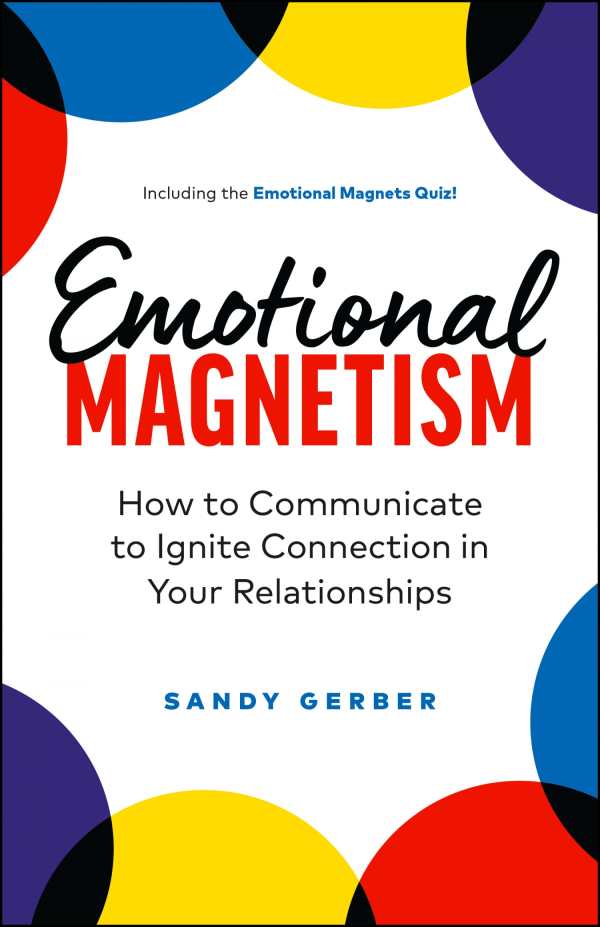It looks like you've stumbled upon a page meant to be read by our code instead of viewed directly. You're probably looking for this page.
Emotional Magnetism
How to Communicate to Ignite Connection in Your Relationships
Emotional Magnetism is a self-help book aimed at couples and businesspeople who hope to cultivate more empathetic relationships.
Sandy Gerber endorses conscientious communication in Emotional Magnetism, a self-help book about improving personal and professional relationships.
People are driven by their emotional needs more than their wants or practicality, says Gerber. This makes knowing their emotional magnets—a collection of personal motivations—vital when handling conflict in personal and professional relationships. Gerber names four emotional magnets: safety (the need for stability), achievement (the need for recognition and goal-setting), value (expediency in time and resource management), and experience (a desire for adventurous affairs). The book suggests that knowing one’s own magnet fosters more effective communication and that such increased awareness will lead to increased empathy, too, since anticipating others’ needs will become easier in everyday relationships.
Each section builds on itself in a cohesive sequence: First, the four emotional magnets are identified and defined; then, blockages that inhibit communication for each of the magnets are covered; and finally, there is information on how such knowledge can be applied in one’s relationships. The sections contain thorough analyses of potential communication difficulties for each magnet too. A discussion of three general communication blockers—solo (self-centered derailments), helper (solution-oriented hyperfocus), and analyzer (failure to listen due to inquisitive distraction)—is particularly insightful and is applicable to many kinds of relationships. This structure supports the internal thesis that learning about one’s own motivations and limitations first will allow for the pursuit of better communication with others.
Traits and conflicts between the four emotional magnets are outlined with famous figures and instances from Gerber’s personal life. As an example of a value-oriented person, the founder of Walmart, Samuel Moore Walton, is said to have provided customers with expedient prices by reducing package waste and shipping costs. However, differences between the personality types are muddled due to the book’s stress on supposed diametric opposites like experience versus safety and safety versus achievement. The quiz to assess one’s type, too, contains generalized wording that suggests that some magnets, like value and safety, are quite similar. The text acknowledges the quiz’s and magnet types’ situational limitations, though.
The book’s message of clear and effective communication via empathy is robust. Gerber addresses how different life experiences and cultural backgrounds will change a magnet’s expression throughout a lifetime. But too little space is devoted to nuanced concepts like the inherent differences between Swedish ideas of success versus American ones. Conflicts between emotional magnets are streamlined to highlight the necessity for more empathy, awareness, and sensitivity toward others’ needs, with examples of interpersonal arguments and miscommunication becoming the focus. Emphasis is placed on the modern corporate workplace and marital relationships as well. Concepts like the need for a two-way street of communication, the effects of social context, and the differences between effective communication and manipulation are mentioned but are explored only in broad detail. Regardless, this work lays a strong foundation for self-awareness and effective communication in romantic relationships and in the workplace.
Emotional Magnetism is a self-help book aimed at couples and businesspeople who hope to cultivate more empathetic relationships.
Reviewed by
Aleena Ortiz
Disclosure: This article is not an endorsement, but a review. The publisher of this book provided free copies of the book and paid a small fee to have their book reviewed by a professional reviewer. Foreword Reviews and Clarion Reviews make no guarantee that the publisher will receive a positive review. Foreword Magazine, Inc. is disclosing this in accordance with the Federal Trade Commission’s 16 CFR, Part 255.
